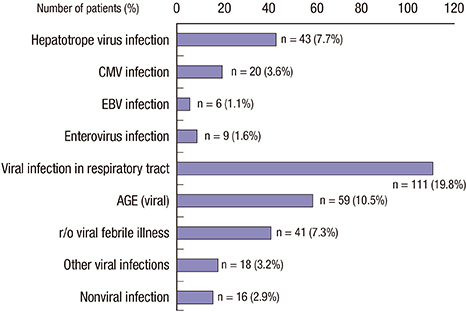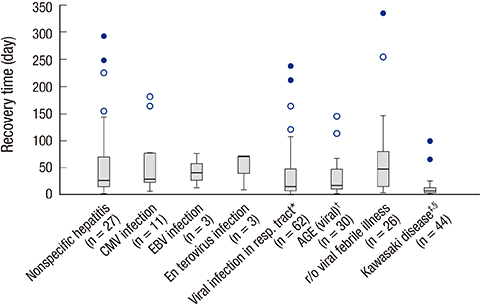Distribution of Diseases Causing Liver Function Test Abnormality in Children and Natural Recovery Time of the Abnormal Liver Function
- Affiliations
-
- 1Department of Pediatrics, Jeju National University School of Medicine, Jeju, Korea. kskang@jejunu.ac.kr
- KMID: 2470275
- DOI: http://doi.org/10.3346/jkms.2016.31.11.1784
Abstract
- Although liver function test abnormality is frequently noted in children, there is no report about the distribution of the etiology and natural recovery time of the abnormal liver function. From March 2005 to February 2014, clinical information was retrospectively collected from 559 children who had abnormal liver function and were hospitalized or visited the outpatient clinic at the Jeju National University Hospital. The etiology of abnormal liver function was classified into groups and the natural recovery time of abnormal liver function was analyzed. The etiological groups of 559 patients included 'nonspecific hepatitis' in 42 (7.5%), 'infection' in 323 (57.8%), 'rheumatologic and autoimmune' in 66 (11.8%), 'nonalcoholic fatty liver disease' in 57 (10.2%), 'anatomic' in 12 (2.1%), 'toxic' in 13 (2.1%), 'metabolic' in 8 (1.4%), 'hematologic' in 7 (1.3%), 'hemodynamic' in 4 (0.7%), and 'others' in 27 (4.8%). Among the 'infection' group (57.8%), the 'viral infection in the respiratory tract' subgroup, which had 111 patients (19.8%), was the most common. The natural recovery time of the abnormal liver function was 27 days (median) in 'nonspecific hepatitis', 13 days (median) in 'viral respiratory tract disease', 16 days (median) in 'viral gastroenteritis', 42 days (median) in 'viral febrile illness", and 7 days (median) in "Kawasaki disease". The information on the natural recovery time of abnormal liver function may help the physician to perform good clinical consultation for patients and their parents.
Keyword
MeSH Terms
Figure
Cited by 2 articles
-
A Multicenter Study of Real-world Practice for Management of Abnormal Liver Function Tests in Children with Acute Infectious Diseases
Yoon Lee, Dae Yong Yi, Yoo Min Lee, So Yoon Choi, You Jin Choi, Kyung Jae Lee
J Korean Med Sci. 2021;36(47):e310. doi: 10.3346/jkms.2021.36.e310.A Report on a Nationwide Surveillance System for Pediatric Acute Hepatitis of Unknown Etiology in Korea
Kyung Jae Lee, Jae Sung Ko, Kie Young Park, Ki Soo Kang, Kunsong Lee, Jeana Hong, Soon Chul Kim, Yoon Lee, Ben Kang, Yu Bin Kim, Hyun Jin Kim, Byung Wook Eun, Hye-Kyung Cho, Yae-Jean Kim, Mi Jin Kim, Jin Lee, Taek-Jin Lee, Seak Hee Oh, Sowon Park, Eun Ha Hwang, Sangjun Sohn, Jin Gyu Lim, YooJin Kim, Yeoun Joo Lee
J Korean Med Sci. 2023;38(47):e401. doi: 10.3346/jkms.2023.38.e401.
Reference
-
1. Kang KS. Abnormality on liver function test. Pediatr Gastroenterol Hepatol Nutr. 2013; 16:225–232.2. Pratt DS. Liver chemistry and function tests. In : Feldman M, Friedman LS, Brandt LJ, editors. Sleisenger and Fordtran’s Gastrointestinal and Liver Disease. 9th ed. Philadelphia, PA: Elsevier Saunders;2010. p. 1227–1238.3. O’Brien CB. The hospitalized patient with abnormal liver function tests. Clin Liver Dis. 2009; 13:179–192.4. Astegiano M, Sapone N, Demarchi B, Rossetti S, Bonardi R, Rizzetto M. Laboratory evaluation of the patient with liver disease. Eur Rev Med Pharmacol Sci. 2004; 8:3–9.5. McKenna JP, Moskovitz M, Cox JL. Abnormal liver function tests in asymptomatic patients. Am Fam Physician. 1989; 39:117–126.6. Johnson PJ. Role of the standard ‘liver function tests’ in current clinical practice. Ann Clin Biochem. 1989; 26:463–471.7. Yazigi N, Balistreri WF. Viral hepatitis. In : Kleigman RM, Stanton BF, St. Geme JW, Schor NF, Behrman RE, editors. Nelson Textbook of Pediatrics. 19th ed. Philadelphia, PA: Elsevier Saunders;2011. p. 1393–1403.8. Steigmann F, Szanto PB, Meister HP, Pamukcu F. Clinical significance of nonspecific (reactive) hepatitis. Am J Gastroenterol. 1965; 44:129–137.9. Schaffner F, Popper H. Nonspecific reactive hepatitis in aged and infirm people. Am J Dig Dis. 1959; 4:389–399.10. Suriawinata AA, Thung SN. Acute and chronic hepatitis. Semin Diagn Pathol. 2006; 23:132–148.




